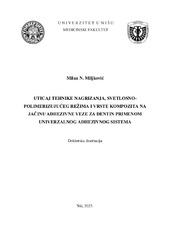Приказ основних података о дисертацији
Uticaj tehnike nagrizanja, svetlosno-polimerizujućeg režima i vrste kompozita na jačinu adhezivne veze za dentin primenom univerzalnog adhezivnog sistema
| dc.contributor.advisor | Dačić, Stefan | |
| dc.contributor.other | Mitić, Aleksandar | |
| dc.contributor.other | Bošković, Mirjana | |
| dc.contributor.other | Popović, Jelena | |
| dc.contributor.other | Petković, Dušan | |
| dc.creator | Miljković, Milan | |
| dc.date.accessioned | 2023-10-20T20:56:57Z | |
| dc.date.available | 2023-10-20T20:56:57Z | |
| dc.date.issued | 2023 | |
| dc.identifier.uri | http://eteze.ni.ac.rs/application/showtheses?thesesId=8627 | |
| dc.identifier.uri | https://fedorani.ni.ac.rs/fedora/get/o:1919/bdef:Content/download | |
| dc.identifier.uri | https://plus.cobiss.net/cobiss/sr/sr/bib/119312649 | |
| dc.identifier.uri | https://nardus.mpn.gov.rs/handle/123456789/21797 | |
| dc.description.abstract | Strong adhesive bond between the dentin and composite is mandatory for long-lasting composite restorations. However, establishing an optimal bond between two completely different substrates is extremely complex and depends on many different factors. This study aimed to examine and compare the influence of different etching modes, light-curing regimens and composite resin types on the immediate shear bond strength (SBS) to dentin using universal adhesive system. A total of 120 samples, consisting of flat dentin plates and cylindrical composite build-ups bonded by universal adhesive (3M Scotchbond Universal Adhesive), were formed to achieve the goal of this study. By combining different etching modes (total-etch / self-etch), composite resin types (conventional / bulkfill) and light-curing regimens (standard / modified), a total of 8 experimental groups were formed (n=15). Shear bond strength test was performed in a universal testing machine and failure force was recorded. Failure sites were examined via scanning electron microscopy. Out of three variables considered, Multivariate ANOVA showed significant interaction was found for variables composite resin type (p<0,001) and etching mode (p=0,001), while the influence of light-curing mode was insignificant (p=0,083). Significantly higher SBS was obtained when bulkfill composite was used compared to the conventional one (p<0,001), as well as total-etch mode compared to self-etch mode (p=0,005). The SBS differs significantly depending on the failure mode. Mixed failure mode was predominant in all sample groups. Adhesive failure resulted in lowest SBS (18,69±2,36 MPa), while cohesive failure in dentin resulted in highest SBS (31,67±4,64 MPa). Proper selection of dental restorative material and etching mode are of crucial importance for the formation of a strong adhesive bond and longevity of the composite filling. The strongest adhesive bond is achieved when total-etch mode and bulkfill composites are used, so they should be preferred whenever possible in the given clinical conditions. The use of modified light-curing regimens does not contribute to higher bond strength and requires further improvement and standardization. | en |
| dc.format | application/pdf | |
| dc.language | sr | |
| dc.publisher | Универзитет у Нишу, Медицински факултет | sr |
| dc.rights | openAccess | en |
| dc.rights.uri | https://creativecommons.org/licenses/by-nc-nd/4.0/ | |
| dc.source | Универзитет у Нишу | sr |
| dc.subject | jačina adhezivne veze, tehnika nagrizanja, svetlosna polimerizacija, kompozitne smole, univerzalni adhezivi, fraktografska analiza | sr |
| dc.subject | shear bond strength, etching mode, light curing, composite resin, universal adhesive, fractographic analysis | en |
| dc.title | Uticaj tehnike nagrizanja, svetlosno-polimerizujućeg režima i vrste kompozita na jačinu adhezivne veze za dentin primenom univerzalnog adhezivnog sistema | sr |
| dc.type | doctoralThesis | |
| dc.rights.license | BY-NC-ND | |
| dc.identifier.fulltext | http://nardus.mpn.gov.rs/bitstream/id/155744/Doctoral_thesis_14153.pdf | |
| dc.identifier.fulltext | http://nardus.mpn.gov.rs/bitstream/id/155745/Miljkovic_Milan.pdf | |
| dc.identifier.rcub | https://hdl.handle.net/21.15107/rcub_nardus_21797 |



